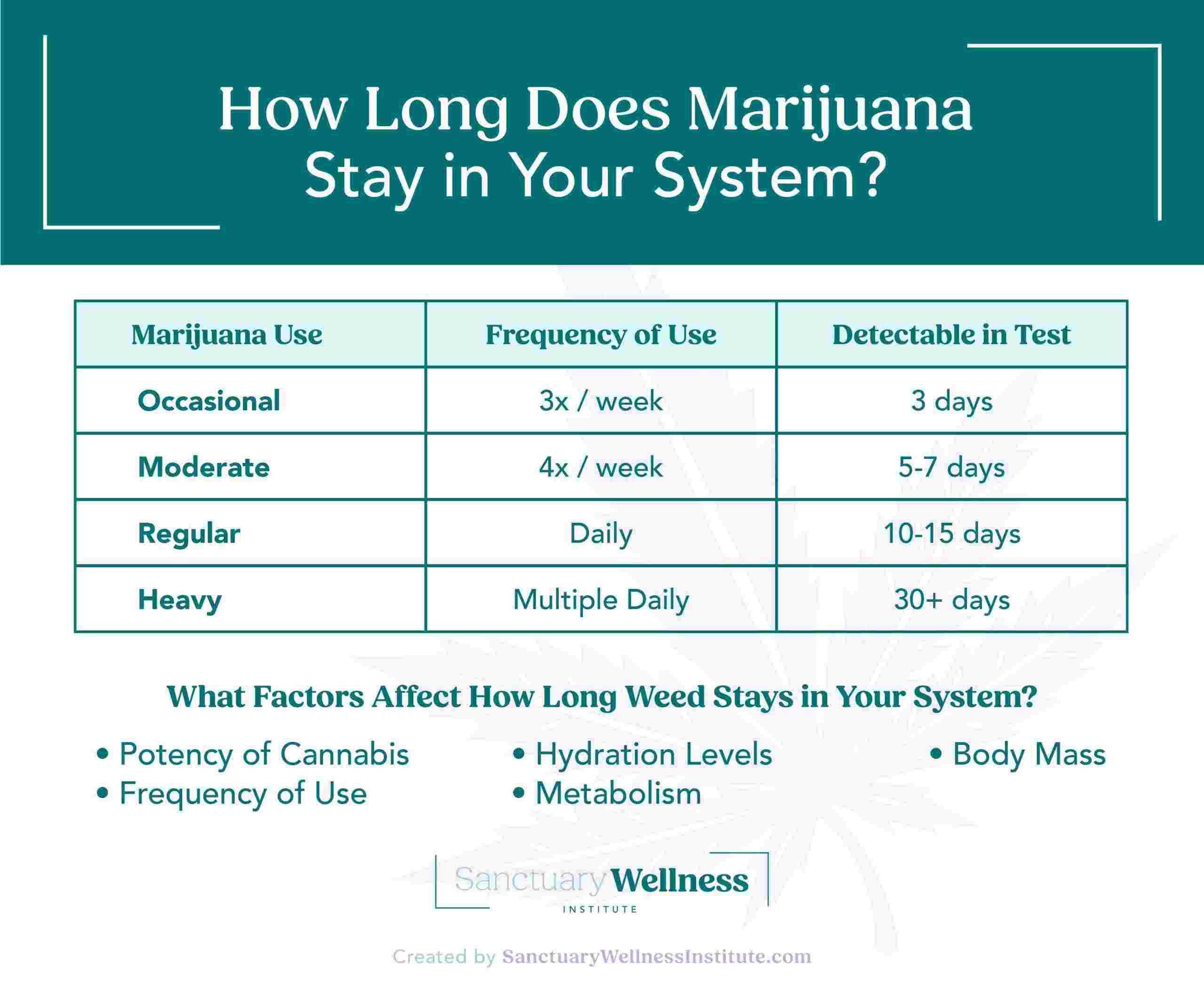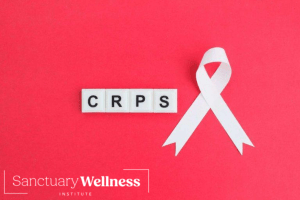How Long Does Medical Marijuana Stay in Your System?
- John DiBella
- Published: December 15, 2021
- Updated: February 16, 2024
- Fact-checked by Dr. Desiree Granados

Marijuana is one of the most commonly used drugs worldwide. While some consume it for recreational purposes, others utilize it for its medicinal benefits. However, a common concern among users is how long THC, the active ingredient in marijuana, lingers in the body. In this article, we’ll explore the complexities of THC retention in the human body and provide a comprehensive guide to understanding how long marijuana stays in your system.
How Long Does Cannabis Stay in Your System?
The duration marijuana stays in your system is variable and depends on several factors, including the potency of the marijuana and your individual metabolism. Typically, THC–the active compound in marijuana–lingers in the blood for one to two days after a single use. That said, for heavier marijuana users, THC may be detectable for weeks or even months.
According to research by Mayo Clinic Laboratories, THC is generally detectable in a drug test accordingly:
- Occasional marijuana use (3 times a week or less): Detectable within 3 days
- Moderate marijuana use (4 times a week or less): Detectable within 5 to 7 days
- Regular marijuana use (daily): Detectable within 10 to 15 days
- Heavy marijuana use (multiple times a day): Detectable for more than 30 days
What Factors Affect How Long Weed Stays in Your System?
Factors that determine how long weed remains in a person’s system are multifaceted and vary among individuals. These factors include:
- Frequency of use – Regular users are likely to retain THC in their systems for longer than occasional users.
- Body mass – Body mass plays a significant role, as THC is lipophilic and tends to accumulate in fatty tissues, prolonging detection times in individuals with higher body fat percentages.
- Metabolism – Users with faster metabolisms may process and eliminate cannabinoids more rapidly than those with slower metabolic rates.
- Potency of the cannabis – Marijuana with higher levels of THC is likely to stay in your system longer. Typically, edibles are more likely to remain detectable in your system longer than smoking.
- Hydration levels – Dehydration can increase the potency of THC, while drinking enough water can help flush the drug from your system. Be aware, however, that drinking water is unlikely to affect the outcome of a drug test.
Also note that the sensitivity of a given drug test can affect results. Most standard drug tests in the U.S. use a cutoff of 50 nanograms/milliliter (ng/mL) for cannabinoids, which is likely to detect THC levels in the urine if you have consumed marijuana in the last few days. More sensitive tests, such as those with a cutoff at 20 ng/mL, are rarer but might detect marijuana as far back as 30 days.
How Long Does Marijuana Stay in Your Urine?
How long marijuana stays in your urine depends upon several factors, including your frequency of use, body fat percentage, metabolism, and the potency of the marijuana consumed. Occasional users may find that marijuana is detectable in their urine for up to three days, while regular users may discover it can be found for up to 30 days after their last use.
Some heavy users have reported detection windows even longer, indicating a great degree of variability from person to person.

How Long Does CBD Stay in Your System?
CBD, or cannabidiol, is a compound found in cannabis plants that has gained widespread attention for its potential health benefits. How long CBD remains in your system can vary considerably based on several factors, including method of consumption, dosage, frequency of use, and individual metabolism.
Typically, CBD stays in one’s system for two to five days, but for some people it can linger for weeks.
How to Get Marijuana Out of Your System
When looking to eliminate marijuana from your system, it’s essential to understand that the time it takes varies from user to user due to factors such as metabolism, frequency of use, and the body’s fat content. Hydration is a key, as increasing water intake can flush out toxins. Exercise can also expedite the process since it can eliminate fat cells where THC is stored.
However, bear in mind that these methods can take time, and the most reliable way to get marijuana out of your system is to allow your body to naturally detoxify regardless of how long it takes. If you know a drug test is coming up, the best approach is to refrain from marijuana for at least a week prior if possible.
If you are a medical marijuana patient and have a drug test coming up, you should consult with your doctor about how best to prepare. You should also look into your state’s laws about drug testing for employees. Laws vary from state to state regarding what kind of action an employer may or may not take against an employee who tests positive for cannabis use.
Get Your Medical Marijuana Card Through the Sanctuary
The Sanctuary Wellness Institute simplifies the MMJ card process by providing educational resources and guiding you through the journey of obtaining a card. When you choose the Sanctuary, you not only gain access to medical marijuana doctors who are deeply knowledgeable about the therapeutic benefits of cannabis, but also compassionate staff members who will prioritize your comfort and satisfaction.
Procuring a medical cannabis card can be a daunting task, but the Sanctuary is ready to help you get one so you can begin treating your qualifying condition(s) as soon as possible.
States Where We Offer Medical Marijuana Card Services
How we reviewed this article:
- Mayo Clinic Laboratories. Marijuana Δ9-Tetrahydrocannabinol (THC) https://www.mayocliniclabs.com/test-catalog/drug-book/specific-drug-groups/marijuana
- Alice Twu (2022). What to Know About How Long Marijuana Stays in Your System https://www.webmd.com/mental-health/addiction/what-to-know-about-how-long-marijuana-stays-in-your-system
- Priory (2024). How Long Does Weed/Marijuana Stay In Your System? https://www.priorygroup.com/blog/how-long-does-weed-stay-in-your-system
- Carly Vandergriendt (2023). How Long Does Cannabis Stay in Your System? https://www.healthline.com/health/how-long-does-weed-stay-in-your-system
- Dan Wagener (2022). How Long Does Marijuana (Weed) Stay in Your System? https://americanaddictioncenters.org/marijuana-rehab/how-long-system-body
- Victor Madril (2023). How Long Does CBD Stay in Your System https://cbdforlife.us/blogs/news/how-long-does-cbd-stay-in-your-system
- NP Addiction Staff (2022). How To Detox From Marijuana https://npaddictionclinic.com/blog/how-to-detox-from-marijuana/
Current Version
February 16, 2024
Written By
John DiBella
Fact-checked By
Dr. Desiree Granados
Editorial Process
Our Editorial Process
First Published
December 15, 2021
Written By
John DiBella
Fact-checked By
Dr. Desiree Granados
Editorial Process
Our Editorial Process

John DiBella is the co-founder and CEO at The Sanctuary Wellness Institute. His goal is to foster healthier lifestyles to improve individuals’ quality of life and health span through online medical and non-medical services. When he’s not writing health & wellness articles for The Sanctuary, he enjoys hiking, camping, surfing and sailing.







